Now You See Us: Women Artists in Britain, 1520–1920
Reviewed by Meaghan ClarkeMeaghan Clarke
University of Sussex
Email the author: m.e.clarke[at]sussex.ac.uk
Citation: Meaghan Clarke, exhibition review of Now You See Us: Women Artists in Britain, 1520–1920, Nineteenth-Century Art Worldwide 23, no. 2 (Autumn 2024), https://doi.org/10.29411/ncaw.2024.23.2.20.
This work is licensed under a Creative Commons Attribution-NonCommercial 4.0 International License  unless otherwise noted.
unless otherwise noted.
Your browser will either open the file, download it to a folder, or display a dialog with options.
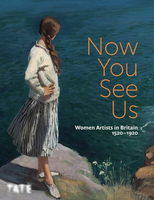
Now You See Us: Women Artists in Britain, 1520–1920
Tate, London
May 16–October 13, 2024
Catalogue:
Tabitha Barber and Tim Batchelor, eds.,
Now You See Us: Women Artists in Britain 1520–1920.
London: Tate Publishing, 2024.
224 pp.; 182 color illus.; list of exhibited works; selected bibliography; index.
£40.00 (hardcover)
ISBN: 9781849769259
The Tate’s exhibition Now You See Us: Women Artists in Britain 1520–1920 is a welcome and arguably overdue counterpoint to an emphasis on the work of male artists in public collections,[1] exemplifying museums’ recent efforts to be more inclusive. Through the work of one hundred professional women artists represented by over two hundred objects, it argues that women were a constant presence in the art world from 1520 onward. The exhibition introduces visitors to the artists’ careers and asks why many have been largely excluded from mainstream art histories.
The title appears above the entrance in bold capital letters, somewhat reminiscent of a movie theatre. To the right of the exhibition entrance, the Tate has affixed portraits of twelve of the artists featured in the exhibition, acting as a visual precursor to what is effectively a chronological hang covering a considerable period of approximately four centuries.
Paintings that use allegory to claim creative artistic powers for women draw the visitor into the dark blue anteroom of the exhibition. Angelica Kauffmann’s roundel for the Royal Academy depicts Invention as female, while the Italian artist Artemesia Gentileschi presents herself as an allegory of painting (fig. 1). Gentileschi’s only other surviving royal commission, Susanna and the Elders (Royal Collection, London) is shown alongside works by women artists of the Tudor court.[2] The space broadens out to explore four of the first professional women artists working in Britain during the seventeenth century, notably the highly successful portraitist Mary Beale (fig. 2).
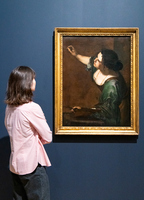
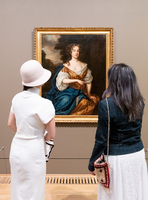
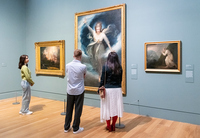
The next section, “First Women Exhibitors,” focuses on the early Royal Academy (established 1768), founding members Angelica Kauffman and Mary Moser, and their contemporaries. The large-scale portraits and history paintings in the room make clear that women artists were a consistent presence in the academy, garnering elite and royal patronage. Vitrines in the center of the room show careful academic studies of the human figure. At the far end of the room, the figure of the Duchess of Devonshire in a portrait by Maria Cosway emerges, life-size, out of a cloud (fig. 3). The show’s premise is made even more clear by a fortuitous overlap in scheduling that made it possible to see the Kauffmann solo exhibition at the Royal Academy on the same day.[3]
Around the corner, glass cases reveal what was excluded from the Royal Academy in a section titled, “Just What Ladies Do for Amusement,” a dismissal courtesy of Joshua Reynolds, then president of the Royal Academy. These included the “lesser arts” of needle painting in a self-portrait by Mary Knowles (fig. 4) and early nineteenth-century portrait miniatures by Anne Mee and Sarah Biffin.[4]
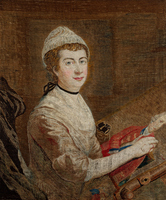
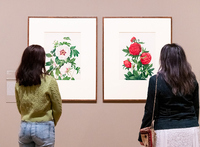
A separate room entitled “Flowers” features extraordinarily detailed paintings by Moser and Clara Maria Pope, one of several women who worked as botanical illustrators (fig. 5). Mary Gartside’s hand-colored volume on color theory (1808) is displayed in a case in the center, while Rosa Brett’s meticulous Pre-Raphaelite Thistles (1860; private collection), signed with the male pseudonym Rosarius, is a bridge into the next space.
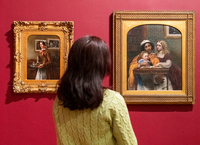
“Victorian Spectacle” addresses the fascination with exhibitions as they multiplied to become an international phenomenon. In the large, brightly lit room, the sizeable canvases of later Victorian artists, presented on bold red walls, impress viewers from a distance. Immediately to the right are earlier Pre-Raphaelite works on a smaller scale, with the short career of Joanna Mary Wells represented by an exquisite angel in Thou Bird of God (1861; private collection). Several artists offer clues about the lives of working women. Rebecca Solomon’s Sherry, Sir? (ca. 1858–62; private collection) and A Young Teacher (1861; Tate and the Museum of the Home, London) depict a servant and a professional caretaker, the latter modeled after the Jamaican-born artist’s model and domestic worker Fanny Eaton (fig. 6).[5] To the left of the entrance, Emily Osborn’s Nameless and Friendless (1857; Tate, London) portrays a woman artist visiting a dealer, while Florence Caxton’s political satire “Woman’s Work”: A Medley (1861; Martin Beisly Fine Art, London) includes a portrait of the famous French artist Rosa Bonheur, whose Sheep in the Highlands (1857; Wallace Collection, London) hangs to its right.[6]

Like Bonheur and Osborn, the battle painter Elizabeth Butler secured wealthy patrons including Queen Victoria. Butler’s Roll Call (1874; Royal Collection, London), an image of frozen, beleaguered soldiers answering the roll call after battle in Crimea, was so celebrated that it had to be guarded by a policeman at the Royal Academy (fig. 7). Butler narrowly missed membership in the Royal Academy due to the male members closing ranks to exclude her after she won the first ballot; the 1879 voting record and her photograph are in a case near the painting.
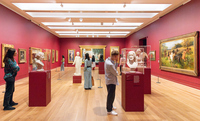
In the center of the room are three mid-century sculptures that suggest a wider transatlantic context where gender, class, and race intersect. Susan Durant’s portrait bust of Harriet Beecher Stowe (ca. 1857; Castle Howard Collection, York), the abolitionist and women’s suffrage activist, was shown at the Royal Academy and the 1862 International Exhibition.[7] American Harriet Hosmer’s Puck on a Toadstool (ca. 1850s; Rotherham Museums, Arts and Heritage, Rotherham) also gained international success; Hosmer was a leader in a community of American neoclassical artists working in Rome, where materials and workshops were more accessible. Another artist working in Rome was the Indigenous (Mississauga, Anishinaabe/Ojibwe) and Black sculptor Edmonia Lewis. Her Bust of Christ (1870; The Bute Collection at Mount Stuart, Isle of Bute), was commissioned by the Marquess of Bute in 1870, and Lewis, who was Catholic, also completed works centered on abolitionist and Indigenous themes, eventually moving to Paris and then London (fig. 8).[8]
The walls around the sculptures lead into the 1870s and 1880s, when London offered new opportunities for exhibiting artworks that were favorable to female artists. The visitor is introduced to artists who took up French-influenced plein air painting. Both the Canadian artist Elizabeth Armstrong Forbes and Austrian artist Marianne Stokes were associated with the New English Art Club and the Newlyn School after moving to Cornwall. Stokes’s Passing Train (1890; private collection) is evocative of modernity: a woman in a vibrant red cloak shares the canvas with steam in motion (fig. 9). The canvas was shown at the newly opened Grafton Gallery; like many of her colleagues, Stokes took advantage of the manifold exhibiting opportunities emerging for artists.
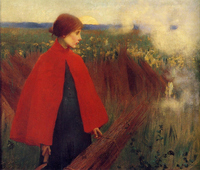
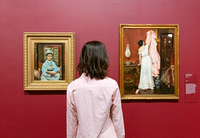
Works by the portrait artist and activist Louise Jopling are featured on the opposing wall: Through the Looking Glass (1875; Tate, London), a newly acquired self-portrait, and a painting of a female model dressing entitled A Modern Cinderella (1875; private collection) (fig. 10). Jopling was a highly successful artist who exhibited widely; A Modern Cinderella was included in the 1878 Exposition Universelle in Paris. Additionally, Jopling was one of several artists who campaigned publicly for suffrage and women’s education.[9]
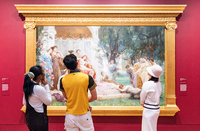
Women were determined to demonstrate expertise in figure painting, seeking training in life study outside the academy. The display of nudes at the 1885 Royal Academy resulted in an extended furor in the Times, in part because women artists were among the exhibitors.[10] Occupying much of the end wall of the gallery, Henrietta Rae’s enormous Psyche Before the Throne of Venus (1894; private collection), exhibited at the Royal Academy in 1894, was perhaps the ultimate riposte to critics (fig. 11). Rae was actively involved in contemporary exhibition culture, sitting on the Hanging Committee of the Liverpool Autumn Exhibition, and curating the Women’s Section of the 1897 Victorian Era Exhibition, the catalogue of which is displayed in a vitrine in front of the painting.[11] Rae’s work is flanked by a large-scale female nude, Annie Louisa Swynnerton’s Mater Triumphalis (1892; Musée d’Orsay, Paris), which was exhibited at the New Gallery and the 1893 Columbian Exhibition in Chicago. Swynnerton was the only artist in the room to gain associate membership in the Royal Academy, albeit not until in 1922.[12]
Later nineteenth-century works include those by women artists who exhibited at the Grosvenor Gallery (opened 1877), the home of Aestheticism or “art for art’s sake.” Laura Alma Tadema, who had a highly successful career, painted interiors influenced by seventeenth-century Dutch painting, while other Grosvenor Gallery artists, such as Evelyn de Morgan and Marie Spartali Stillmann, were more directly linked with late Pre-Raphaelitism. The intensely colored neo-Pre-Raphaelitism of Deceitfulness of Riches (1901; private collection) by Eleanor Fortescue Brickdale was exhibited at the Royal Academy in 1901, coinciding with her solo show at the Dowdeswell Galleries.[13]
After “Victorian Spectacle,” the visitor moves through three smaller spaces dedicated to the mediums of watercolor and photography, followed by art training. The first features landscapes by Barbara Bodichon, founder of the Langham Place Circle, a reform collective in the 1850s, and artists who established reputations in the medium later in the century, such as Helen Allingham and Rose Barton.[14]
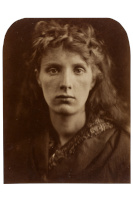
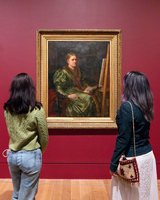
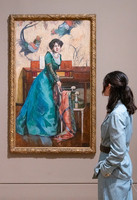
Women were early practitioners of the new medium of photography as evidenced by the albumen prints by Julia Margaret Cameron (fig. 12) and Clementina Hawarden. In the darkened niche to the right of the exhibition space is a selection of later prints by women who shared the aesthetic interests of the Linked Ring—such as Eveleen Myers, Zaïda Ben-Yúsuf and Gertrude Käsebier—despite no women being elected members until 1900. Jewel-like, backlit facsimiles of autochromes evidence the work of photographers, including Olive Edis, who experimented with color in the early twentieth century.[15]
The final nineteenth-century section continues the conversation begun earlier in the exhibition, “Art School.” One wall is occupied by a blown-up photograph of female students at the Slade, founded in 1871, where—unlike the Royal Academy—women were not barred from life study. Bodichon, who organized the 1859 petition calling for admission to Royal Academy Schools, is present at her easel in a portrait by Osborn, as is Jopling, who operated an independent art school that prioritized direct study from nude life models (fig. 13). Adjacent to these are examples of nude studies by women students.
Now You See Us culminates in the diversity of engagements with modernism and politics of the early twentieth century. Works by Ethel Walker, who exhibited at the New English Art Club and the Women’s International Art Club, include the impressionist The Garden (ca. 1899; Bradford District Museums and Galleries, CBMDC) and the fresco-like Decoration: The Excursion of Nausciaa (1920; Tate, London), which depicts an ethereal female community.[16] Nearby are vividly colored works by the acclaimed figurative artist Laura Knight, who finally achieved full Royal Academy membership in 1936, and Ethel Wright’s The Music Room: Portrait of Una Dugdale (ca. 1912; private collection) in which Dugdale wears a striking, suffrage-green dress (fig. 14).[17] Larger paintings of war work face more intimate portrait and still life pieces by Gwen John, Vanessa Bell, and abstract studies by Vorticist Helen Saunders.[18]
In sum, Now You See Us is expansive and richly diverse with material. Many of the loans are from private collections, giving visitors the opportunity to view rarely seen, and even unknown, works. There are several large loans from the Royal Collection, a welcome addition to a more accessible, albeit ticketed, space. There are many opportunities for close examination of archival evidence, for example of ongoing advocacy for access to training and women’s rights. A real strength of the exhibition is its attention to the contemporary critical reception of the work; this is often revealing and amplifies the curator’s argument that, in many cases, women were successful professionals within their own lifetimes. At the same time, it is clear that “woman artist” is not a unified category; contemporary sources and the works themselves evidence radically different experiences of professional practice. Not surprisingly, gender intersects with class, ethnicity, and race.
The exhibition and catalogue aim to explore four hundred years of women artists as exhibitors and as navigators of public institutions and societies. Curator Tabitha Barber begins her catalogue essay “Faint Footprints in the Sand” by citing Ellen Clayton’s condemnation of the Royal Academy for its exclusion of women artists; as Barber observes, Clayton’s 1876 two-volume work English Female Artists, dedicated to none other than Elizabeth Butler, provides an historical precedent for establishing the existence of professional artists (11–15). The catalogue is structured around the exhibition’s sections; this is useful in introducing artists and works, some of whom are more familiar than others. Rather than longer essays, short texts related to individual artists or groups of artists are given thematic subheadings. Importantly, the works are made visible through plentiful color illustrations, occasionally supplemented by small photographs or reproductions from the press that give a flavor for the breadth of the show. There are many contributors, indicated by initials, and these include scholars who have amassed a wealth of expertise.[19]
A disadvantage of such an enormous undertaking is that many of the artists or chronological periods would merit an exhibition of their own. It is sometimes difficult to think more broadly about how the works might have related to stylistic trends and movements within the periods they were produced, not to mention their political, social, and cultural contexts. While some artists are represented by more than one example of their work, the oeuvres of each, plentifully displayed in many blockbusters dedicated to male artists, remain unknown (admittedly in some cases unknowable due to the absence of surviving works) and, of course, not all are represented.[20] The Royal Academy show that gives Kauffmann solo status demonstrates an alternative.
Moreover, visitors may ask why women artists or artist-women require segregation to be “seen.” Ironically, this show is in a sense a reimagining of the “Woman’s Work Section” in the Victorian Era exhibition Rae curated in 1897; at the time many women, including Butler, were anxious about the subcategorization of women’s work in exhibitions. Many, though not all, artist-women in the nineteenth century were actively engaged in egalitarian, feminist politics and subsequent attempts at women’s exhibitions were not unanimously welcomed.[21]
Now You See Us is not unique in its approach; over the past year there has been a flurry of exhibitions of work by women in Europe and North America.[22] Why is the theme recurring in 2024? Not only is there evidence of an historical ambivalence, but there have now been decades of feminist scholarship on several of the artists featured in the show.[23] In the catalogue essay entitled “Travelling Hopefully,” Pamela Gerrish Nunn recounts her experience of curating such a show at the Nottingham Castle Museum in 1982 (16–19). Digital research has productively opened new arenas of inquiry, yet the prevalence of professional women artists in the nineteenth century has been long established.[24] Nonetheless, narratives centered on sensational biography and uniqueness, or discovery, repeat in discussions of women artists. These approaches complicate attempts to dislodge canonical rhetoric or forestall cyclical remembering and forgetting.
What Now You See Us does highlight is the lack of representation of women in big museums. While several of the artists have been featured in solo exhibitions, especially in recent years, these have often been in galleries outside London. Moreover, national institutions have been implicated in the process of “unseeing” women artists.[25] The shift in public collections, such as the Tate, to collect and display more work by women is much more recent.
The purpose of artist-women shows now, as then, is tactical. Many of the artists in Now You See Us are still not represented in major public collections (or they have remained unseen, languishing in store). Therefore, large group shows can contribute to institutional shifts by reorienting collections. The aspirations of Now You See Us are and will be manifested in acquisitions and displays in permanent galleries.[26]
Notes
[1] As the Guerrilla Girls have so memorably observed in poster form since 1985, see “Guerrilla Girls,” Tate, https://www.tate.org.uk/visit/tate-modern/display/media-networks/guerrilla-girls.
[2] Gentileschi was the subject of a blockbuster exhibition at the National Gallery in 2020–21; see “Artemesia,” National Gallery, https://www.nationalgallery.org.uk/exhibitions/past/artemisia.
[3] Angelica Kauffmann, (London: Royal Academy of Arts, March 1–June 30, 2024).
[4] Sarah Biffin’s work has been on display at the Holbourne Museum, Bath. Biffin painted with her mouth because she was born without arms. Sarah Biffin (Holbourne Museum, September 29, 2023–January 14, 2024).
[5] The work of Pre-Raphaelite women artists was the subject of an exhibition at the National Portrait Gallery in 2019–20. See Mariëlle Ekkelenkamp, “Pre-Raphaelite Sisters,” Nineteenth-Century Art Worldwide 19, no. 1 (2020), https://doi.org/10.29411/ncaw.2020.19.1.13; Jan Marsh et al., Pre-Raphaelite Sisters (London: National Portrait Gallery, 2019). See also early scholarship and recently edited volumes on the topic: Jan Marsh, Pre-Raphaelite Sisterhood (London: Quartet, 1985); Jan Marsh and Pamela Gerrish Nunn, Pre-Raphaelite Women Artists (Manchester: The Galleries, 1997); Deborah Cherry, Painting Women: Victorian Women Artists (London: Routledge, 1993); Jan Marsh and Pamela Gerrish Nunn, Women Artists and the Pre-Raphaelite Movement (London: Virago, 1989); Deborah Cherry, Beyond the Frame: Feminism and Visual Culture, Britain 1850–1900 (London: Routledge, 2000); Glenda Youde and Robert Wilkes, Pre-Raphaelite Sisters: Art, Poetry and Female Agency in Victorian Britain (Oxford: Peter Lang, 2022); Katie J. T. Herrington, ed., Victorian Artists and Their World, 1844–1861: As Reflected in the Papers of Joanna and George Boyce and Henry Wells (Woodbridge: Boydell & Brewer, 2024).
[6] These works, as above, have also been the subject of considerable feminist scholarship. On Osborn, see Deborah Cherry, “Going Places: Women Artists in Central London in the Mid-Nineteenth Century,” The London Journal 28, no. 1 (May 2003): 73–96, https://doi.org/10.1179/ldn.2003.28.1.73; Pamela Gerrish Nunn, Problem Pictures: Women and Men in Victorian Painting (Aldershot: Scolar Press, 1995).
[7] Shannon Hunter Hurtado, Genteel Mavericks: Professional Women Sculptors in Victorian Britain, Cultural Interactions: Studies in the Relationship between the Arts, vol. 27 (New York: Peter Lang, 2012).
[8] There has been considerable scholarship on this group of US women sculptors; see Charmaine Nelson, “Edmonia Lewis’ Death of Cleopatra: White Marble, Black Bodies and Racial Crisis in America,” in Local/Global: Women Artists in the Nineteenth Century, eds. Deborah Cherry and Janice Helland (Burlington, VT: Ashgate, 2006), 223–43; Patricia Cronin and William H. Gerdts, Harriet Hosmer, Lost and Found: A Catalogue Raisonné (Milan: Charta, 2009); Jacqueline Marie Musacchio, “Mapping the ‘White, Marmorean Flock’: Anne Whitney Abroad, 1867–1868,” Nineteenth-Century Art Worldwide 13, no. 2 (2014), https://www.19thc-artworldwide.org/autumn14/musacchio-introduction.
[9] See Patricia de Montfort, Louise Jopling: A Biographical and Cultural Study of the Modern Woman Artist in Victorian Britain (London: Routledge, 2017); Patricia de Montfort, “Louise Jopling: A Gendered Reading of Late 19th Century Britain,” Woman’s Art Journal 34, no. 2 (2013): 29–38; Maria Quirk, Women, Art and Money in Late Victorian and Edwardian England: The Hustle and the Scramble (New York: Bloomsbury, 2019).
[10] Alison Smith, Exposed: The Victorian Nude (London: Tate Publishing, 2001).
[11] Katie J. T. Herrington and Rose Jarvie, Henrietta Rae (1859–1928) Psyche before the Throne of Venus (London: Martin Beisley Fine Art, 2018); Meaghan Clarke, Critical Voices: Women and Art Criticism in Britain, 1880–1905 (Burlington, VT: Ashgate, 2005); Joanna Devereux, The Making of Women Artists in Victorian England: The Education and Careers of Six Professionals (Jefferson, NC: McFarland, 2016).
[12] Katie J. T. Herrington, Rebecca Milner, and Annie Swynnerton, Annie Swynnerton: Painting Light and Hope (Manchester: Manchester Art Gallery, 2018).
[13] Pamela Gerrish Nunn, A Pre-Raphaelite Journey: The Art of Eleanor Fortescue-Brickdale (Liverpool: Liverpool University Press, 2012); Margaretta S. Frederick and Jan Marsh, Poetry in Beauty: The Pre-Raphaelite Art of Marie Spartali Stillman (Wilmington: Delaware Art Museum, 2015); Margaretta S. Frederick, ed., Evelyn & William De Morgan: A Marriage of Arts & Crafts (New Haven: Yale University Press, 2022).
[14] The scholarship on Bodichon, co-founder of Girton College, includes: Pam Hirsch, Barbara Leigh Smith Bodichon, 1827–1891: Feminist, Artist and Rebel (London: Chatto & Windus, 1998); Cherry, Beyond the Frame; Margaretta S. Frederi, “Politics and Paint: The Life Work of Barbara Leigh Smith Bodichon,” in Pre-Raphaelite Sisters: Art, Poetry and Female Agency in Victorian Britain, eds. Robert Wilkes and Glenda Youde, (Oxford: Peter Lang, 2022), 121–48.
[15] This section is curated by Hope Kingsley. See also Carol Jacobi, Hope Kingsley, and Elizabeth Jacklin, Painting with Light: Art and Photography from the Pre-Raphaelites to the Modern Age (London: Tate Gallery Publishing, 2016).
[16] Wright was president of the Women’s International Art Club from 1931 to 1945. Warmest thanks to Una Richmond for conversations on the exhibition.
[17] Knight is one of the show’s artists featured in recent solo exhibitions: Laura Knight Portraits, National Portrait Gallery, London; July 11–October 13, 2013; Laura Knight: A Panoramic View, MK Gallery, Milton Keynes; October 9–February 20, 2022; Laura Knight: A Celebration, Penlee House Gallery & Museum, Cornwall; May 17–September 16, 2021; and Dame Laura Knight: I Paint Today, Worcester City Art Gallery and Museum, Worcester; January 13–June 30, 2024.
[18] The 2023 Pallant House and Holbourne Museum exhibition Gwen John: Art and Life in London and Paris was curated by Alicia Foster, curator of the final section of the Tate exhibition; Vanessa Bell: A World of Form and Colour opens in the autumn at the MK Gallery. On Saunders, see Alicia Foster, Radical Women: Jessica Dismorr and Her Contemporaries (London: Lund Humphries in association with Pallant House Gallery, 2019).
[19] See references above for many of these including Nunn, Marsh, Kingsley, Foster, and de Montfort.
[20] For example, the “Being Modern” section includes little on abstraction.
[21] The Victorian Era exhibition displayed photographs by Cameron and Myers in a section on applied art and handicraft; the latter is otherwise absent from the nineteenth-century portion of Now You See Us. Meaghan Clarke, Fashionability, Exhibition Culture and Gender Politics: Fair Women, (London: Routledge, 2021).
[22] Ingenious Women. Women Artists and their Companions, Bucerius Kunst Forum Hamburg, October 14, 2023–January 28, 2024 and Kunstmuseum Basel, March 2–June 30, 2024; Making Her Mark: A History of Women Artists in Europe, 1400–1800, Baltimore Museum of Art, October 1, 2023–January 7, 2024 and Art Gallery of Ontario, March 27–July 1, 2024; Maestras (Women Masters), Museo Nacional Thyssen-Bornemisza, October 31, 2023–February 4, 2024.
[23] The catalogue’s select bibliography indicates a growing field that began with early publications by Griselda Pollock, Pamela Gerrish Nunn, Deborah Cherry, and Jan Marsh. See also the 2016 British Art Studies issue asking some of these same questions. Patricia de Montfort and Robyne Erica Calvert, “Still Invisible?,” British Art Studies 2 (2016), https://doi.org/10.17658/issn.2058–5462/issue-02/still-invisible. Many thanks to colleagues in the British Women Artists Network and National Gallery’s Women and the Arts Forum for symposia and lively discussions on this theme.
[24] This is made more evident in the recent study of early exhibition records; see Heidi A. Strobel, book review of A Revolution on Canvas: The Rise of Women Artists in Britain and France, 1760–1830 by Paris A. Spies-Gans, Nineteenth-Century Art Worldwide 22, no. 1 (2023), https://doi.org/10.29411/ncaw.2023.22.1.13.
[25] As Barber notes, the erasure of women artists in the twentieth century parallelled the establishment of the discipline of art history. For an alternative approach to the mid-century surveys, see the republished, Woman in Art: Helen Rosenau’s ‘Little Book’ of 1944 (New Haven: Yale University Press, 2023).
[26] This is highlighted in the show with “New Acquisition” printed on object labels. The rehang of the Free Collection at the Tate includes works by artists represented in the show; see “Historic and Early Modern British Art: Trace the Story of British art from the Tudors to WWII,” Tate, https://www.tate.org.uk/.